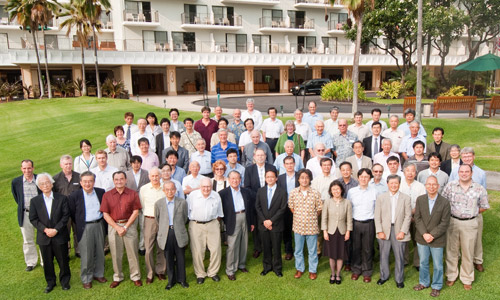Topics
US and Japan celebrate a 30-year collaboration in High Energy Physics
12 Nov 2010
A symposium was held in Hawaii from 20 to 22 October to celebrate 30 years of a US-Japan collaboration under the US-Japan Agreement on High Energy Physics established in 1979, aiming to promote joint research and development on accelerators and detectors using accelerator facilities in the United States. This project was carried out as part of the implementation of a broader collaboration on energy signed by the governments of the U.S. and Japan.

by courtesy of Brookhaven National Laboratory
Many successful research programs have been carried out under this collaboration, notably the discovery of the top quark. In addition to its scientific results, this collaboration also played a major role in human resource exchange: many younger Japanese researchers who joined the project have become leaders in both national universities and research institutes.
More than 80 participants joined the symposium, including representatives from the funding agencies, the US Department of Energy (DOE) and Japan's Ministry of Education, Culture, Sports, Science and Technology (MEXT), as well as executives and researchers from participating laboratories: Brookhaven National Laboratory (BNL), Fermi National Accelerator Laboratory (Fermilab), Lawrence Berkeley National Laboratory, the Stanford Linear Accelerator Center (SLAC: now reorganized as SLAC National Accelerator Laboratory) and KEK.
During the symposium, participants reviewed the accomplishments and contributions of the US-Japan collaboration, and discussed future collaboration to develop and expand the US-Japan partnership.
In the early stage of the collaboration, the U.S. played a leading role with its superb knowledge and advanced accelerator facilities. The collaborative activities in that period consisted mainly of Japanese researchers carrying out experiments at the state-of-the-art accelerator facilities in the US, including the Positron Electron Project at SLAC, the Tevatron at Fermilab and fixed target experiments at SLAC, BNL and Fermilab.
Over the last three decades, the collaboration evolved. Now, KEK welcomes many researchers, not only from the US but from Europe and Asia, who utilize KEK's facilities in conjunction with international collaborative projects such as the Belle collaboration, which is dedicated to proving the Kobayashi-Maskawa theory and helping to explain the violation of CP symmetry. KEK expects increasing participation of scientists from all over the world in T2K, high intensity kaon and muon experiments at J-PARC, and in Belle II with the upgraded KEKB accelerator.